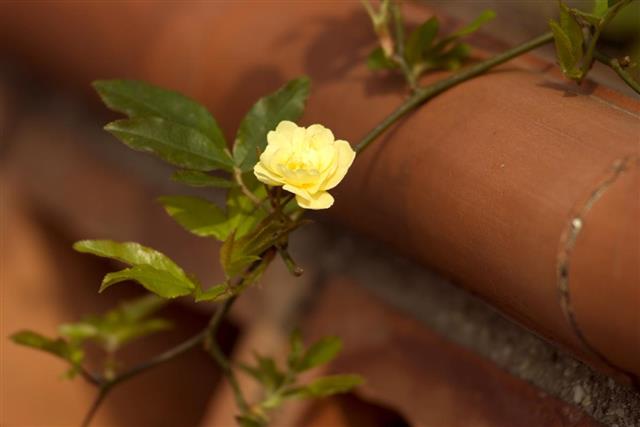
Have you ever come across bright yellow roses on a climbing plant? If yes, then you must have seen the plant we are talking about: the Lady Banks’ rose. In this article, we shall learn how to cultivate Lady Banks’ rose.
The Lady Banks’ rose (Rosa banksiae normalis) was first cultivated during the late 18th century. The plant is a native of China, where it is found growing on altitudes as high as 500-2000 m above sea level. It is named after the wife of one of the members of the Captain Cook expedition, Sir Joseph Banks, who was a botanist. There are two different types of Lady Banks’ rose: white and yellow. The Lady Banks’ rose blooms in clusters and the white variety (Rosa banksiae banksiae) is double-flowered. Later, Rosa banksiae lutescens, a double-flowered yellow variety, was also found.
The plant has sturdy branches and can also be grown as small shrubs that attain a height of 3 to 4 feet. When climbing trees or other supports, these lovely plants can attain a height of over 30 feet. The diameter of the flowers varies from 1 to 2.5 cm and are double or semi-double, depending on the sub-species. A reason for you to opt for Lady Banks’ rose instead of other types of roses, is the complete absence of thorns. This makes it easier for you to prune and take care of the plant. Now, we all love our roses in spite of the thorns but cultivating a rose without thorns is a different experience altogether!
Cultivating Lady Banks’ Rose
The Lady Banks’ rose blooms during spring and is an evergreen plant. The most interesting fact about Lady Banks’ rose is that it is very strongly resistant to fungal diseases and other infections. Rarely will you find mildew or spots on the plant. One of the advantages of growing Lady Banks’ rose is that it grows easily on almost all types of soil and needs very little care and maintenance. Here we’ll have a look at the different things you should take into consideration for cultivating a Lady Banks’ rose.
Type of Soil
The soil is an important factor to consider when planting the Lady Banks’ rose. Soil rich in nutrients and organic matter is best recommended. So, after you plant the Lady Banks’ rose, add essential quantities of organic fertilizers and manure to the soil. This way your plant will easily acquire all the nutrients it needs and will grow happily! However, these drought tolerant plants are unable to withstand excessive moisture in the soil and hence, are best grown in well-drained soils.
Method of Propagation
Since the Lady Banks’ rose is a species rose and not a hybrid, you can obtain true specimens from the seeds. However, the plant, like other species of roses, is propagated through stem-cuttings. You can get stem-cuttings at the local nursery.
Choosing a Support
To make your Lady Banks’ rose grow, you first need to bind the plant to a sturdy support. Since it is a climbing plant, it is not necessary that you always have to construct vertical supports for it to grow on. You can be creative and grow it next to arches, porch pillars, fences, lampposts, etc. These plants simply have the ability to beautify just anything! You can trim the plant to give it any shape you like.
Sun or Shade?
When you plant a Lady Banks’ rose in your garden, plant it in an area that receives the maximum sunlight, for the plant rarely grows well in shade. Also, for optimum growth, give your rose plant ample space to happily spread its branches. The Lady Banks’ rose is unable to withstand temperatures below 15°F.
Watering Your Plant
When it comes to watering the plant, all you need to do is water the stem-cutting regularly till it takes root. Once it begins to grow, you need not water the plant frequently.
Pruning the Plant
Unlike most other plants in your garden that bear flowers on newly grown shoots, the flowers of the Lady Banks’ rose grow on old branches. This is the reason why you should never prune the plant before spring, which is the flowering season for the plant. Once the plant has flowered in spring for 4 weeks or so, you can safely prune the plant to allow new shoots to develop. The plant has a tendency to spread its branches far and wide, and so it is necessary that you prune it often to keep it in shape and confine it to the area within which you want it to grow. Remember that pruning the Lady Banks’ rose is essential for its growth and well-being.
The largest Lady Banks’ rose is one that is over 125 years old and can be found in Tombstone, Arizona. It is lovingly referred to as the “Shady Lady”. This shows that a well cared for Lady Banks’ rose can indeed survive for years together!


